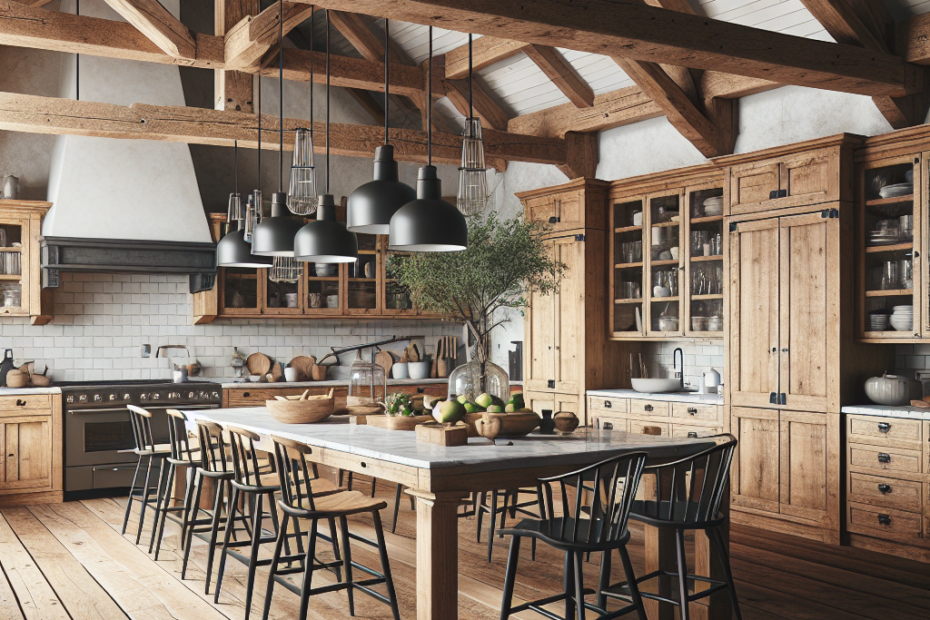“`html
Embracing Rustic Design in Modern Kitchens
In recent years, the trend of blending rustic design with modern kitchens has captivated homeowners and designers alike. They recognize the need for a warm, inviting space that also features contemporary conveniences. This harmonious blend brings together the best of both worlds, creating kitchens that are not only visually stunning but also highly functional. By understanding the essentials of rustic design for modern kitchens, they can transform an ordinary space into a charming and efficient hub of the home.
The Essence of Rustic Design
Rustic design is all about embracing the simplicity and beauty of natural materials. They use wood, stone, and metal elements to create an earthy color palette and a timeless feel. Unlike other design styles that strive for perfection, rustic design celebrates imperfections and natural textures. This approach allows homeowners and designers to create spaces that feel lived in and comforting.
Key Elements of Rustic Design in Kitchens
- Natural Materials: Wood dominates the scene, often in the form of reclaimed wooden beams, flooring, or cabinetry. Stone countertops or backsplashes provide an earthy touch, while wrought iron adds an element of toughness and durability.
- Warm Color Palette: The rustic style favors warm and earthy colors. Shades of brown, beige, and cream are predominantly used, with pops of color introduced through accessories like rugs or dishes.
- Handcrafted Details: Handcrafted details such as carved wooden cabinet handles, artisan tile work, or hand-forged metal fixtures add to the uniqueness of the kitchen space.
- Vintage and Antique Elements: Incorporating vintage or antique pieces can provide a sense of history and character. They often use antique furniture, open shelving, or old-fashioned décor to emphasize the rustic feel.
Blending Rustic with Modern Features
Combining rustic elements with modern design involves carefully selecting contemporary features that complement the natural materials. Modern stainless steel appliances blend well with rustic kitchens, providing a sleek contrast against the organic elements. Additionally, state-of-the-art lighting fixtures paired with large windows can enhance the natural light, creating an open and airy environment.
A survey from the National Kitchen & Bath Association (2023) revealed that 42% of kitchen renovations now include rustic design elements, up from 28% in the previous year. This shift indicates a growing appreciation for the warm, inviting atmosphere that rustic designs bring to modern spaces.
| Design Element | Rustic Features | Modern Features |
|---|---|---|
| Materials | Reclaimed wood, stone | Stainless steel, polished surfaces |
| Color Scheme | Earthy tones | Neutral or bold colors |
| Fixtures | Wrought iron, hand-forged pieces | Sleek, minimalist designs |
Creating a Balanced Space
Achieving a balanced rustic-modern kitchen starts with a clear vision. They should focus on maintaining the rustic charm while incorporating enough modern elements to ensure functionality. Using too many rustic elements can cause the space to feel outdated, while excessive modern features might overshadow the rustic charm. A 2022 report by Houzz noted that kitchens that skillfully mixed rustic and modern elements saw a 17% higher increase in perceived home value compared to other styles.
Accessories also play a vital role in enhancing the rustic-modern kitchen. Functional yet aesthetic pieces, such as copper pans, woven baskets, or wooden cutting boards, can add a layer of authenticity to the space. Choosing lighting that showcases some rustic features, like pendant lights with Edison bulbs, helps bridge the gap between the old and new.
Key Takeaways
- Rustic design for modern kitchens merges natural materials with contemporary elements to create warm and functional spaces.
- Essential rustic features include natural materials, warm color palettes, handcrafted details, and vintage elements.
- Modern elements such as stainless steel appliances and innovative lighting enhance the functionality and appeal of rustic kitchens.
- A balanced blend of rustic and modern elements can significantly increase the perceived value of a home.
FAQ
-
What is rustic design?
Rustic design emphasizes the use of natural materials like wood, stone, and metal, focusing on simplicity and earthy tones.
-
How can rustic design be incorporated into a modern kitchen?
Rustic design can be incorporated by using natural materials in cabinetry, countertops, and flooring, paired with modern appliances and lighting fixtures.
-
Why is rustic design popular in modern kitchens?
Rustic design is popular because it creates a welcoming and warm atmosphere, blending traditional elements with modern convenience.
-
What are some popular materials for a rustic-modern kitchen?
Popular materials include reclaimed wood, stone, stainless steel, and wrought iron, which together offer a harmonious contrast.
-
Can rustic design increase the value of my home?
Yes, homes with a well-executed blend of rustic and modern design elements tend to have higher perceived value according to recent home reports.
“`
